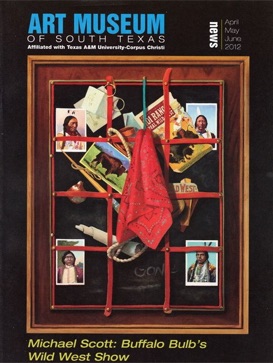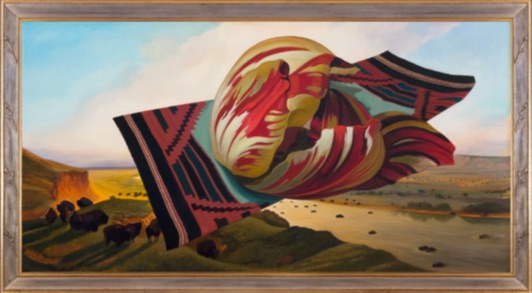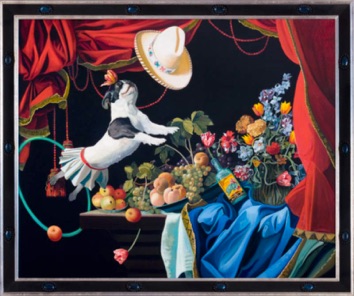Art Museum of South Texas

Q and A with Michael Scott
(for the April, May, June Newsletter)
How did this show come about and How does your work in Buffalo Bulbs Wild West Show address the function and necessity of beauty in historic terms??
The most interesting things in life often happen by accident.
My own obsessive need to observe beauty, to dance with brilliant color, symmetry, and form has led me down more than one rabbit hole. That is how I found myself one October day outside a tavern in Amsterdam where I encountered merchants with baskets and baskets of tulips and bulbs. Without realizing it, I was observing one of the great market mysteries of all time. Holland during the 1600s was the setting for one of the strangest episodes in all of economic history. Tulip Mania, as it is known, elevated the value of a single bulb to the equivalent of an $18 million apartment on New York’s Park Avenue.
Tulip-crazed people were bidding on fantasy strains of the flower that had yet to be planted in Dutch soil.
As I listened to the flower merchants crash course in tulip history, I couldn’t keep my eyes off the velvet surfaces and array of designs in the flowers. I was completely enveloped by them, tuning in and out of the merchants words and expressions.
“Surmounting everything else, beyond economic disaster, beyond human gullibility and beyond our helplessness to resist hype is the beauty of the flower itself “. I heard a merchant say. At that moment I saw the foundation for what would be the Buffalo Bulbs Wild West Show. Take a flower that represents beauty, which has perfect symmetry, has no scent- then bottle it, and selling it, to an eve- hungry ever-gullible, public. What an idea!
But the concept presented one central challenge: who would be the salesman? The answer of course was that all American larger-than-life icon of huckerstering --- Buffalo Bill Cody. This was the man who sold the “West” to Europe and now he was going to use his marketing skills to sell Europe to the west.
The bait, was beauty--the unqualified, irreproachable loveliness of the tulip. It would work; unfurl the banners, and let the hype begin.
What does this work say about contemporary art’s function in our world today?
I try not to say too much about art as function that starts to get a bit preachy. However I do believe that if you provide the viewer a broad non- singular experience in a work then they can dig as far as they want to dig. There are always layers of information in paintings, good paintings, and I think each layer has a story, and that story is attached to another story. Context plays a role here, meanings can be found in the context , content relationships. It is that mingling which tends to open up ones perceptual realities. It’s all about discovery.
Why have you chosen a highly realistic style known as trompe l’oeil (a painting which creates the illusion of actually being what it sets out to depict)?
Trompe l’ oeil painting is all about the illusion. It plays out the visual trick-within the picture plane. I like to take it a bit further and play out the conceptual trick the emotional trick and bring attention to the fact that one must look harder and think further before reaching conclusions. It’s a wonderful device and provides another layer to the conversation about what is true and what is not.
In some cases the character of Buffalo Bill looks very much like you. Why have you chosen to do this?
I am the cheapest model I know and readily available.
Do you believe there is such a thing as too much of a good thing, and if so, what cost is implied in this particular series?
I believe that everything works fairly well in moderation—things get squid when greed kicks in however, that’s when things fall apart. If you use the metaphor that the tulip and Art are the same, that they can both represent beauty, this idea is attached to an experience that enriches us and tends to inspire. It is not singular and is wonderfully expansive. But when these same objects are solely used to manipulate wealth then that turns them into a commodity, and the conversation about them is mostly attached to making money and potential greed. That in turn then makes them singular; and establishes a different kind of gratification.
What role do the Native Americans play in this drama?
This is a tough question because it is so loaded. I will try to be brief.
The American Indian has been used over and over again as an icon of the west. Often times romanticized and marketed as symbols. The perception of the Indian changed drastically depending on the period and context it was viewed in . You had the nomadic wanderer which we associate with boundless freedom, the noble savage, the warrior, the scout for the white frontiersman, in addition you had the Indian as advertising symbols, which were attached to America’s expansionism; Then onward to TV and movie roles in the 50’s until present. I basically incorporated four Indian chiefs depicted in postcard format from the turn of the century as part of the Wild West Troop. They were chosen purely on their time period and their visual interest. I felt this to be important because their original portrayal falls into its own form of snake oil; i.e. the marketing of a romantic Indian and its place in the west. They show up in a number of different paintings representing different ideas in each. Native American’s were a huge part of Buffalo Bills original troop and were valued as such. The west would not be the west without them.
In this exhibition we have included actual objects that you used as subjects in the paintings themselves. Some of these items are vintage cans and other material. Why have you chosen to include these in the exhibition?
Often times I find props in flea markets. I guess you could say that I am a flea market junkie. There is always something there to discover and I usually get lucky. Also Flea markets provide an interesting combination of past and present. I find that to be an interesting mix as well. I think when museums provide the viewer some of the reference information it helps give thought to the original content and how invention plays a role in its new context.
What role do you see
artist’s playing in the
economic and cultural
climate today, espec-
ially your own?
I like to think of my role
as a participant in a disco-
very process, looking for
visual cues and creating
out of that. It is completely
process driven and less
about product motivation.
The ideas are attached to
the “now” and I use history
to make comparisons to the
present. This combination
creates a kind of a conceptual
cocktail where culture’s and
histories collide. I did however develop the idea to produce several products with the
Buffalo Bulbs exhibit in the same manner as the marketed souvenir. It seemed appropriate to complement the show with an assortment of memento’s which would reflect on the kind of keepsakes that the original Wild West shows had produced.
Like other economic models Art is subject to the laws of supply and demand. More and more you see Artist and dealers participating in the control and manipulation of the value of the work. It becomes a form of cultural snake oil, particularly when an artist work is hyped without substantive merits and artificially propped up. Trends play a role as well; it’s very much like the hype associated with the fashion industry. What’s in this year is out the next! You always need something new to create the next buzz. The prices of works are often dictated by when and where they entered the market; which directly relates to context.
An example would be, if you’re a graffiti artist tagging subway cars your value is zero and considered a criminal.
However if the same artist is shown at the MoMa and given a retrospective then the work has market value. This recently was demonstrated when graffiti artist Jason Choe was hired to tag the walls at FaceBook headquarters, being paid in stock now worth over 200 million. This type of hype and can be compared to the tulip bulb analogy, time will tell as to how Mr. Choe will fair in the art world. It’s hard to forecast and navigate in this water, and it has become somewhat of a spectator sport. It really doesn’t have much to do about the Art.
My rule of thumb is this, it takes time to find your voice and it is without question ongoing work.
I think the best thing to do is to make work that you yourself believe in- and hold true to the ideas you want to explore. Never chase trends, because you can never catch up. The pendulum will swing back and forth, the key is to be ready, with a bit of luck and good timing it will catch you at some point.
If you were not an artist what do you think you would be doing instead?
Most likely I would be a gardener and a chef.
Deborah Fullerton, Curator
Art Museum of South Texas
1902 N. Shoreline Blvd.
Corpus Christi, Texas 78401


